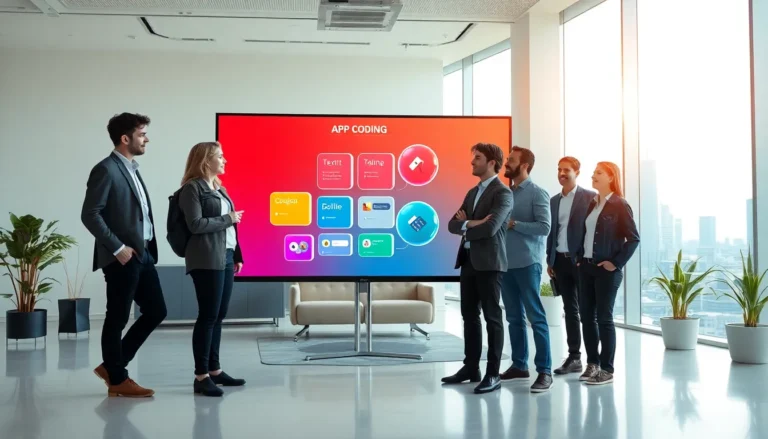In today’s digital landscape, the demand for tech-savvy individuals is skyrocketing. However, not everyone has the luxury of a coding background. The good news is that zero coding experience doesn’t have to be a barrier to success. With a wealth of resources and tools available, anyone can learn how to navigate the tech world and even create their own projects.
From drag-and-drop website builders to intuitive app development platforms, technology has evolved to accommodate those without programming skills. This article explores how individuals can leverage these tools to bring their ideas to life, regardless of their technical background. Embracing a no-code or low-code approach opens doors to creativity and innovation, making it possible for anyone to contribute to the digital economy.
Table of Contents
ToggleUnderstanding Zero Coding Experience
Zero coding experience refers to the ability to engage with technology and create projects without any prior knowledge of programming. This concept resonates with many individuals eager to participate in the digital landscape.
Definition and Importance
Zero coding experience involves utilizing tools and platforms that don’t require traditional coding skills. These tools empower users to build websites, applications, and prototypes through visual interfaces. The importance of zero coding experience lies in democratizing technology. It enables individuals from diverse backgrounds to bring their ideas to life and fosters innovation without the barriers typically associated with software development.
Common Myths and Misconceptions
Many myths exist surrounding zero coding experience.
- Myth: Only programmers can build websites or apps.
Reality confirms that no-code platforms allow anyone to create digital projects without needing programming knowledge.
- Myth: No-code solutions lack functionality.
Many no-code and low-code tools come equipped with powerful features, enabling complex projects without writing a single line of code.
- Myth: It’s only for non-technical users.
While designed for beginners, these platforms also assist seasoned developers in speeding up prototyping and implementation.
- Myth: It lacks customization.
Users can often customize templates and create unique projects tailored to specific needs, challenging this misconception about limitations.
Understanding these myths helps clarify the capabilities of zero coding experience, encouraging more individuals to explore their creative potential in technology.
Tools and Platforms for Beginners

Various tools and platforms cater to individuals with zero coding experience. These resources empower users to create projects with ease, using visual interfaces and intuitive designs.
No-Code Development Platforms
No-code development platforms enable users to build applications without writing code. Users can drag and drop components to create functionalities seamlessly. Popular options include:
- Bubble: A versatile platform for building interactive web applications using visual elements and workflows.
- Adalo: A no-code platform focused on creating mobile applications with simple design tools.
- Webflow: A web design tool that combines visual editing with CMS capabilities, ideal for building responsive websites.
These platforms democratize application development, allowing individuals to execute ideas rapidly without technical barriers.
Visual Programming Tools
Visual programming tools leverage graphical interfaces to simplify coding concepts for beginners. Users manipulate visual elements instead of writing traditional code. Noteworthy examples include:
- Scratch: An educational platform that teaches programming basics through block-based coding, suitable for all ages.
- App Inventor: A Google-backed initiative that enables users to develop apps for Android devices using visual components.
- Thunkable: A platform designed to create mobile applications using a drag-and-drop interface, perfect for novices.
These tools enhance understanding of programming logic while enabling the creation of functional projects, making technology accessible to everyone.
Benefits of Zero Coding Experience
Zero coding experience opens doors for many individuals to engage with technology creatively. Several key benefits arise from this approach, empowering users to take charge of their projects without formal programming training.
Accessibility for Non-Techies
Accessibility defines the zero coding experience. Intuitive platforms cater to individuals without technical knowledge. User-friendly interfaces enable them to easily navigate tools and create software, websites, or applications. The simplification of complex processes encourages participation from various demographics, including educators, entrepreneurs, and artists. Ultimately, this increased accessibility promotes innovation and creativity among non-techies.
Rapid Prototyping and Development
Rapid prototyping and development exemplify key advantages of zero coding experience. Users can quickly transform ideas into tangible projects using no-code development platforms. These tools facilitate iterative design and immediate testing, significantly reducing development time. For example, a startup founder can develop a functional MVP (Minimum Viable Product) in weeks instead of months, allowing for faster market validation. This quick approach fosters an agile mindset and encourages experimentation, leading to more refined and successful final products.
Challenges Faced by Beginners
Beginners with zero coding experience encounter several challenges when navigating tech tools and resources. These hurdles can impede progress but understanding them promotes better preparedness and adaptability.
Learning Curve and Resources
The learning curve for beginners often presents obstacles. Familiarizing with no-code platforms requires time and practice. Many resources exist, including tutorials, forums, and online courses. Engaging with these materials fosters skill development and enhances confidence. However, underestimating the effort needed to grasp concepts can lead to frustration. Beginners must maintain patience and actively seek out helpful guides specific to their chosen platforms, ensuring a smoother learning experience.
Getting Stuck and Seeking Help
Encountering obstacles during projects is common for beginners. Many may feel overwhelmed when facing technical issues or struggling to achieve desired results. Identifying when to seek help is crucial. Utilizing community forums, social media groups, and official support channels provides avenues for assistance. Collaboration and networking with others experiencing similar challenges can also prove valuable. Establishing connections with more experienced users or mentors can expedite problem-solving and inspire continued learning.
Real-World Applications
Zero coding experience offers significant real-world applications, demonstrating how individuals across various sectors successfully engage with technology. The following sections delve into successful non-coders and industries adopting no-code solutions.
Case Studies of Successful Non-Coders
- Adele D. – School Administrator: Adele launched a school website using Wix, a no-code platform, enhancing communication with parents and students. The website’s ease of use enabled her to create sections for events, announcements, and resources without coding skills.
- Mark T. – Small Business Owner: Mark built an e-commerce store on Shopify to sell handmade products. By utilizing drag-and-drop features, he streamlined the site setup and launched his business within weeks, driving sales and reaching broader audiences.
- Sarah L. – Artist: Sarah showcased her artwork using Webflow. The platform’s visual interface allowed her to create a stunning portfolio that attracted collectors and art enthusiasts, demonstrating that artists can efficiently present their work online.
- James R. – Entrepreneur: James developed a mobile app using Adalo without any programming knowledge. By leveraging pre-made templates and visual elements, he quickly prototype-tested his app idea, gaining valuable feedback before launch.
Industries Embracing No-Code Solutions
- Education: Educational institutions increasingly implement no-code platforms for creating interactive learning management systems and engaging websites. Tools like Google Sites provide educators with user-friendly options to build resources for students.
- Marketing: Marketing teams utilize platforms like Mailchimp and HubSpot for email campaigns and customer relationship management. These tools empower marketers to design, automate, and analyze campaigns without coding expertise.
- Healthcare: Healthcare organizations adopt no-code applications for appointment scheduling and patient management. Platforms like Airtable enable staff to build customizable solutions that streamline processes, enhancing patient care.
- Finance: Financial analysts leverage no-code tools such as Zapier for workflow automation, connecting different apps, and improving efficiency. These solutions reduce manual input errors and save time in data management.
- Nonprofits: Nonprofits use platforms like Canva and Typeform to create marketing materials and surveys. These tools empower organizations to reach wider audiences and gather feedback without technical hurdles.
Zero coding experience opens doors for countless individuals eager to engage with technology. With an array of no-code tools available, creativity can flourish without the need for extensive programming knowledge.
These platforms empower users from all backgrounds to bring their ideas to life, fostering innovation and collaboration across various sectors. By embracing this approach, anyone can quickly prototype and develop projects, reducing barriers to entry in the digital economy.
As more people discover the potential of zero coding experience, the landscape of technology continues to evolve, encouraging diverse participation and driving progress in an increasingly digital world.










